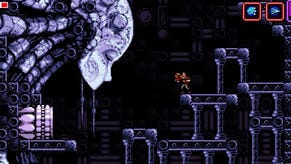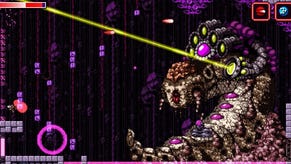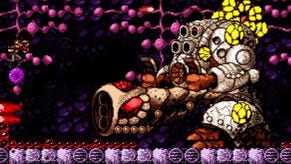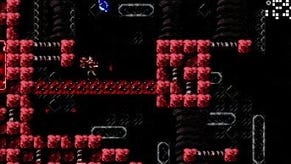Axiom Verge review
Verging on the sublime.
It's usually a good sign when a game opens with scientists muffing things up, leading to disaster. That's how Half Life began, of course, and if you go further back it's also how Another World opens. Trace, the peculiarly named hero of Axiom Verge, is very much in that mould.
His vague experiment leads to an accident which seemingly kills him - except he awakes in a strange new world that, it must be said, looks a lot like a NES game. A mysterious female voice gets him up and moving, and before you know it he's acquired the first of many weapons and is hopping from platform to platform, blasting the weird biomechanical creatures that want to do him in, and trying to find his way back to normality.
In case you haven't guessed from the screenshots, Axiom Verge is a Metroidvania game, that hybrid genre where traditional linear platforming gets shaken up by an ever-expanding suite of gadgets and abilities, each of which allows you to bypass obstacles or access areas that had previously been off limits. The longer you play, the more of the map you can explore.
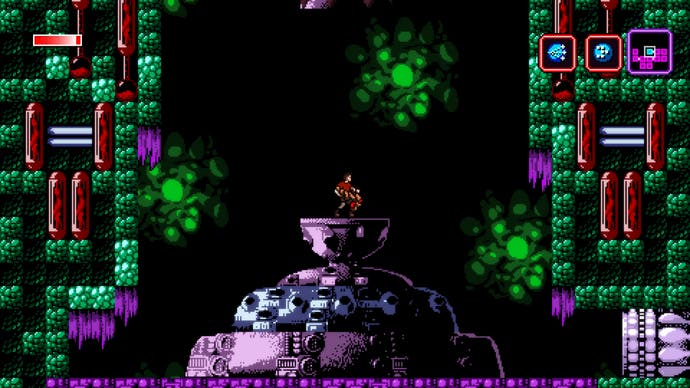
In the tussle between action and exploration, Axiom Verge definitely favours the latter. Each new room or area comes stocked with enemies to kill, but disposing of them is really a prelude to the painstaking task of charting the environment, adding a new pink square to your map with every new screen you reach. Flip-screen tunnels link different areas together, and it's these that you quickly learn to look for.
Do you take every new path that presents itself? Or fully explore the location you're in before hitting an impassable obstacle, then going back and methodically exploring each diversion in search of the tool that will get you past it? Such is the timeless quandary of the Metroidvania player, and it's a question that that Axiom Verge poses both constantly and confidently.
The first weapon you get is the Axiom Disruptor, a simple laser gun useful for blasting enemies but not much else. Next is the Nova, a larger, slower projectile that can be detonated early with a second tap of the fire button. This can be used to hit switches that are otherwise hidden beyond your line of fire, and to damage enemies in the same way. Soon after that you gain a drill, enabling you to chew through some walls and floors, and following that is the Address Disruptor, which corrupts or decorrupts parts of the screen that appear to be glitching, creating new platforms. And so it goes on.

Each new toy comes with its own limitations and specialisms, and the game's puzzle-based undertow comes less from didactic block-shifting, switch-hitting navigation busywork and more from the wider mental challenge of thinking laterally to understand how each new addition to your toolkit can be used - both in areas to come, and areas you've already seen. It's the right way to deliver a Metroidvania experience, requiring a little more long-term investment from the player but rewarding it with a game that is more thoughtful and stimulating.
Movement control is crisp and responsive, as it needs to be for some of the tougher sections, though combat proves less tight. Your arsenal of weapons is accessed with the right stick, while shooting is mapped to the Square button. Trace can fire diagonally, but aiming is attached to the same left stick used for movement. That means that it's impossible to shoot diagonally at enemies without also moving forwards at the same time. Similarly, with the shoulder buttons and triggers used for the drill and other tools, jumping and shooting at the same time is a bit of a fumble, as your thumb hops between X and Square.
That's an entirely legitimate old school trait, and you can remap all the controls however you please, but it never stopped feeling slightly clumsy to me. It's particularly noticeable during the regular boss confrontations, where precise pattern recognition is sometimes held back by the slightly clunky jump-shoot-shoot-shoot-jump-shoot inputs. It's one of the few areas where Axiom Verge trips over its own feet.

Death isn't too much of a hindrance, thankfully. Save points are common enough - appearing as giant egg-like chambers that spin closed to record your progress. Whenever you die, you simply respawn from your most recent save point. Any items or weapons found are still retained, as the game shrewdly understands that while retracing your steps is a key element of the genre, retracing your steps just to reacquire stuff you'd already found quickly becomes a chore. Don't think that this means the game is a lily-livered hand-holder though. The difficulty ramps up very quickly after the first few boss fights, and demands nimble figures and smart thinking to proceed.
Perhaps most remarkably, Axiom Verge is the work of just one man: Tom Happ. From the game's authentic 8-bit colour palette to a catchy soundtrack of pulsing chip tunes, not to mention the sprawling game itself, packed with platforms, enemy types and puzzles that have clearly been obsessed over during the five year development process, this is a very singular vision.
For retro-heads, that makes it something of a treat. Many are the indie games that crib their look and tone from the 1980s, but few really understand the era or the genres they mimic. That's definitely not the case with Axiom Verge, which has clearly been crafted with affection and care by someone who knows the territory inside out and upside down.
It's just a shame that given the obvious talent and passion involved, it doesn't really have much of its own to add to the Metroidvania template. As charmed and delighted as I often was with its smartly paced escalation, its perpetually teasing construction, I kept waiting for some new element to appear, a eureka moment that either hadn't been thought of in 1986, or that could only be done today. It never quite happens. Axiom Verge seems content to be a homage, rather than a revival or reinvention. That's fine, since there's already plenty to justify your interest, but it feels like Happ has more to contribute than he's showing here.




